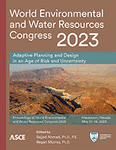Collecting At-Home Water Quality Observations through a Citizen Science Project to Characterize Risk of Lead in Drinking Water
Publication: World Environmental and Water Resources Congress 2023
ABSTRACT
Lead is a toxic metal that can be harmful to human health even at low exposure levels. For homes that draw water from community water systems, the most significant source of lead in the water comes is typically lead service lines or lead pipes that connect homes to the water main. Households that are exposed to high water lead levels (WLLs) should be identified rapidly to mitigate exposure through preventative measures. Laboratory testing of water samples across a community is expensive, and at-home water chemistry test kits are affordable and report water quality parameters, including copper, iron, pH, and lead. At-home chemistry tests, however, are subject to high levels of error and do not reliably identify WLLs. This research explores the use of machine learning approaches to improve the use of at-home water chemistry test results and classify WLLs at households. Water chemistry parameters, such as iron, copper, and pH, and observations of tap water quality, including odor, taste, and discoloration, are correlated with the presence of lead and can be used to predict WLLs in a statistical or machine learning approach. Data were collected by citizen scientists, who used at-home water chemistry test kits and reported household characteristics, plumbing type, build year, water quality observations, and at-home water chemistry reports through a citizen science project, Crowd the Tap. Machine learning methods, including Bayesian Belief Networks models, were applied to use variables reported by participants to classify WLLs above lead thresholds. This research explores and couples machine learning and citizen science methods to predict WLLs in tap water and prioritize laboratory testing of households in a community with high risk of lead.
Get full access to this article
View all available purchase options and get full access to this chapter.
REFERENCES
Castelletti, A., and Soncini-Sessa, R. (2007). “Bayesian Networks and participatory modelling in water resource management.” Environmental Modelling and Software, 22, 1075–1088.
Fasaee, M. A. K., Berglund, E. Z., Pieper, K., Ling, E., Benham, B., and Edwards, M. (2021). “Developing a Framework for Classifying Water Lead Levels at Private Drinking Water Systems: A Bayesian Belief Network Approach.” Water Research, 189(1), 116641.
Fasaee, M. A. K., Pesantez, J., Pieper, K., Ling, E., Benham, B., Edwards, M., and Berglund, E. Z. (2022). “Developing Early Warning Systems to Predict Water Lead Levels in Tap Water for Private Systems.” Water Research, 221, 118787.
Hanna-Attisha, M., LaChance, J., Sadler, R. C., and Champney Schnepp, A. (2016). “Elevated Blood Lead Levels in Children Associated With the Flint Drinking Water Crisis: A Spatial Analysis of Risk and Public Health Response.” American Journal of Public Health, 106, 283–90.
Jensen, F. V. (2001). Bayesian Networks and Decision Graphs. Springer New York.
Kriss, R., Pieper, K., Parks, J., and Edwards, M. A. (2021). “Challenges of Detecting Lead in Drinking Water Using at-home Test Kits.” Environmental Science & Technology, 55(3), 1964–1972.
Lytle, D., Schock, M., Formal, C., Bennett-Stamper, C., Harmon, S., Nadagouda, M., Williams, D., DeSantis, M., Tully, J., and Pham, M. (2020). “Lead particle size fractionation and identification in Newark, New Jersey’s drinking water.” Environmental Science & Technology, 54, 13672–13679.
Pieper, K. J., Katner, A., Kriss, R., Tang, M., and Edwards, M. A. (2019). “Understanding lead in water and avoidance strategies: a United States perspective for informed decision-making.” Journal of Water and Health, 17(4), 540–555.
Pieper, K. J., Martin, R., Tang, M., Walters, L., Parks, J., Roy, S., Devine, C., and Edwards, M. A. (2018). “Evaluating Water Lead Levels During the Flint Water Crisis.” Environmental Science & Technology, 52, 8124–8132.
US EPA. (1991). Maximum Contaminant Level Goals and National Primary Drinking Water Regulations for Lead and Copper; Final Rule. Fed. Regist. 56, 26460.
Wani, A. L., Ara, A., and Usmani, J. A. (2015). “Lead toxicity: A review.” Interdisciplinary Toxicology, 8(2), 55–64.
Information & Authors
Information
Published In
History
Published online: May 18, 2023
ASCE Technical Topics:
- Artificial intelligence and machine learning
- Chemical compounds
- Chemical elements
- Chemicals
- Chemistry
- Computer programming
- Computing in civil engineering
- Engineering fundamentals
- Environmental engineering
- Heavy metals
- Hydrologic engineering
- Hydrologic properties
- Hydrology
- Infrastructure
- Laboratory tests
- Lead (chemical)
- Pipeline systems
- Pipelines
- Tests (by type)
- Water and water resources
- Water chemistry
- Water circulation
- Water pipelines
- Water quality
- Water sampling
- Water treatment
Authors
Metrics & Citations
Metrics
Citations
Download citation
If you have the appropriate software installed, you can download article citation data to the citation manager of your choice. Simply select your manager software from the list below and click Download.
